Estimated reading time: 20 minutes
Introduction
Dog grooming is not just a luxury but a fundamental aspect of pet care, crucial for maintaining the health and happiness of our furry friends. It’s a practice that transcends mere aesthetics, offering numerous benefits that extend well beyond a neat appearance. Home dog grooming, particularly dog trim and dog nail trim, is an intimate bonding experience that allows pet owners to closely monitor their pet’s health, identify any underlying issues early, and ensure their comfort and well-being.
The art of grooming your dog at home encompasses a range of activities – from brushing and trimming their coat to maintaining their paw pads, ear cleaning, and teeth brushing. It’s an all-encompassing routine that helps keep your dog’s coat free from mats and tangles and plays a pivotal role in managing shedding, especially in breeds with an undercoat. Regular grooming sessions provide an excellent opportunity to check for fleas, ticks, and skin irritations, ensuring your dog’s coat and skin stay healthy. Moreover, it’s a chance to bond with your pet, establishing a routine that many dogs grow to enjoy.
Trimming your dog’s nails is another essential aspect of grooming. Neglected nails can lead to pain and discomfort for your dog and, in severe cases, even deformities in the foot. Regular nail trims keep your dog comfortable and protect your floors and furniture from scratches. It’s a delicate task, though, especially if your dog has dark nails, where the quick – the blood vessel running into the nail – is not visible. The proper technique is crucial for a safe and stress-free experience for you and your dog.
This comprehensive guide delves deep into the nuances of home dog grooming. From understanding the essential requirements and assembling the right tools to mastering the techniques for a perfect dog trim and nail trim, we’ve got you covered. We’ll explore the importance of regular grooming for different coat types, from long-haired to short-haired breeds, and provide practical tips for maintaining your dog’s coat between professional grooming sessions. Whether you’re a seasoned dog owner or new to the world of pet care, this guide will equip you with the knowledge and skills to ensure your dog looks and feels its best.
Key Takeaways
- Home Dog Grooming: Understand the comprehensive benefits and importance of grooming your dog at home, including maintaining their coat health and enhancing your bond.
- Essential Tools: Learn about the grooming tools required for effective dog trim and nail care at home.
- Dog Trimming Guide: Master the step-by-step process of dog trim, ensuring a neat and comfortable coat for your furry friend.
- Nail Trim Tips: Gain insights into stress-free dog nail trim techniques, keeping your dog’s paws healthy and preventing discomfort.
- Coat Maintenance: Discover effective strategies for maintaining your dog’s coat between professional grooming sessions, ensuring continuous coat health.
- Grooming Mistakes: Avoid common dog grooming mistakes, ensuring a safe and pleasant experience for your pet.
- Advanced Techniques: Explore advanced dog grooming techniques for those looking to take their skills to the next level.
- Overall Care: Recognize the holistic approach to dog grooming, encompassing the physical appearance and your dog’s overall well-being.
Understanding the Basics of Dog Trim at Home
Overview of Dog Trim at Home
Dog trimming at home is an essential aspect of dog grooming. It’s not just about keeping your pet looking good but also crucial for their health and comfort. For many dog owners, trimming their pet’s coat can seem daunting. However, with the proper knowledge and tools, grooming your dog at home can be a rewarding experience for you and your furry companion. Regular grooming is vital to prevent matting, reduce shedding, and identify underlying skin issues.
Case Study: Consider the case of a Labrador Retriever named Max. His owner started regular grooming sessions at home, including brushing, nail trimming, and ear cleaning. Initially resistant, Max soon began to enjoy these sessions. The consistent grooming helped identify a skin allergy early, leading to a swift veterinary intervention. This real-world example highlights the importance of a grooming schedule and its impact on a dog’s health and well-being.
Preparing Your Dog for a Trim
Preparing your dog for a trim is essential for a smooth grooming process. It involves several considerations to ensure that your dog is comfortable and the trimming is effective. Firstly, choosing a quiet area free from distractions is vital. This helps your dog stay calm and cooperative. Secondly, having all the necessary tools within reach is crucial. These tools include scissors, shampoo, a brush, and anything specific to your dog’s grooming needs. Another important aspect is timing. Initiating the grooming session when your dog is naturally calm and relaxed, such as after a walk or meal, can make a significant difference. Lastly, using positive reinforcement with treats and gentle petting can help create a positive association with grooming, making future sessions easier.
List of Preparation Steps:
- Create a Calm Environment: Choose a quiet and comfortable area to avoid distractions and help your dog stay relaxed.
- Gather Necessary Tools: Assemble all grooming tools, such as scissors, shampoo, and a brush, before starting.
- Choose the Right Time: Opt for a time when your dog is most calm, like after a walk or meal, for a smoother grooming experience.
- Use Positive Reinforcement: Employ treats and affection to make grooming a positive experience for your dog.
Identifying Areas Needing Attention
When grooming your dog at home, it’s crucial to identify the areas that need special attention. Dogs with a double coat or long hair might require more frequent trims. Pay attention to places like the undercoat, around the ears, and the paws. Regularly brush your dog’s teeth and check their ears for signs of infection or irritation.
Health and Safety Considerations
Safety should be a top priority when trimming your dog at home. Use tools formulated for dogs and ensure that they are clean and sharp. Be cautious when trimming around sensitive areas such as the face and paws. If your dog has white nails, it’s easier to see them quickly and avoid cutting them. For dogs with darker nails, take extra care to prevent accidental injury. Regular nail trims are essential, as long nails can lead to discomfort and even skeletal issues in dogs.
Dog trimming at home is a vital part of pet care. It’s more than just a haircut; it’s about maintaining your dog’s health. Grooming includes brushing, bathing, ear cleaning, and nail trimming. By understanding the basics, preparing adequately, and focusing on your dog’s health and comfort, you can ensure a pleasant grooming experience for you and your pet. Remember, a well-groomed dog is a happy and healthy dog!
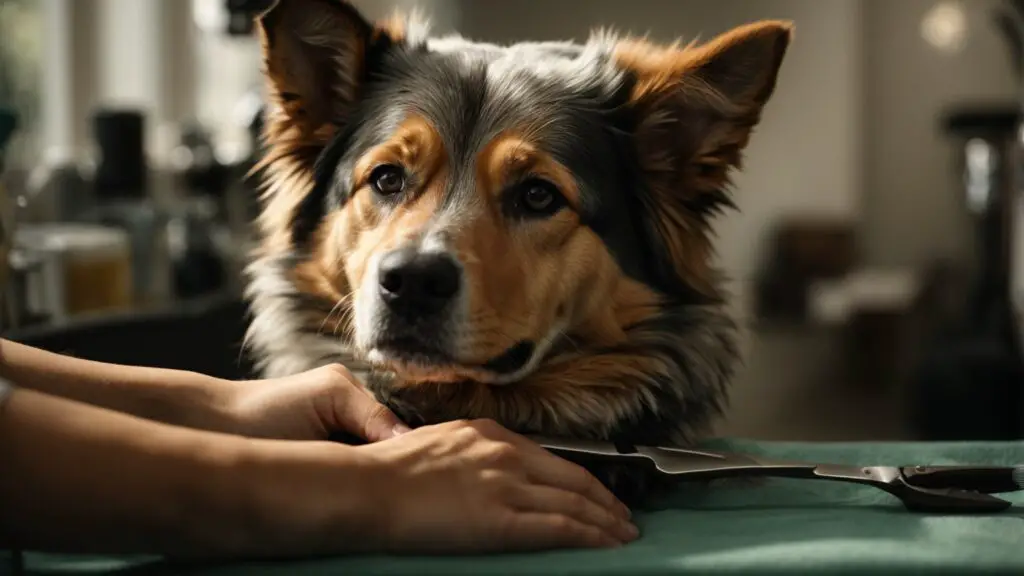
Essential Tools for Home Dog Grooming
Importance of the Right Tools for Dog Grooming
Regarding dog grooming at home, having the right tools is not just a matter of convenience; it’s a cornerstone of effective grooming. The correct tools ensure that grooming is easier, safer, and more comfortable for your dog. Whether it’s a simple nail trim or a full haircut, the quality of your tools can significantly impact the outcome and experience. This becomes even more critical for breeds with specific needs, such as those with an undercoat or dogs requiring regular ear cleaning.
List of Essential Tools
- Clippers: Essential for trimming hair, especially for dogs with longer coats.
- Shears: For more precise cuts and shaping around sensitive areas.
- Combs and Brushes: Different types for various coat textures and lengths.
- Nail Clippers: To keep your dog’s nails at a healthy length.
- Ear Cleaning Solutions and Tools: For regular ear hygiene.
- Shampoo and Conditioner: Explicitly formulated for dogs to maintain healthy skin and coat.
Choosing Quality Grooming Tools
Selecting high-quality grooming tools is crucial. It’s essential to look for tools designed specifically for pets, as human grooming tools may not suit your dog’s skin and coat. For instance, clippers should be sharp enough to cut cleanly without pulling hair, and brushes should be gentle on the dog’s skin. Consulting with a professional dog groomer or veterinarian can provide insights into the best tools for your dog’s breed and coat type. Remember, the investment in quality tools improves the grooming experience and ensures your pet’s safety and comfort.
Care and Maintenance of Grooming Tools
Regular maintenance of your grooming tools is as important as their initial selection. Keeping them clean and in good condition is essential for their effectiveness and your dog’s health. Clippers and shears should be regularly oiled and sharpened, while brushes and combs must be cleaned to remove loose hair and debris. Proper care extends these tools’ lives and prevents skin conditions from spreading between grooming sessions.
A renowned dog groomer once said, “The right grooming tools make all the difference. They are not just tools; they are instruments of comfort and health for your pet.” This emphasizes the role of quality grooming equipment in ensuring a positive grooming experience.
The journey to successful home dog grooming begins with equipping yourself with the right tools. Each plays a vital role in maintaining your dog’s appearance and health, from clippers to shampoos and nail clippers. Quality tools tailored to your dog’s needs and regular maintenance lay the foundation for rewarding grooming, keeping your pet looking and feeling their best. Remember, effective grooming is a blend of skill and the right equipment, and every dog deserves the best grooming experience.
Step-by-Step Guide to Dog Trim
The Process of Dog Trim
Dog trimming is essential to grooming and maintaining your pet’s appearance and overall well-being. Whether you’re a seasoned pet owner or new to dog grooming at home, understanding the step-by-step process of dog trimming can transform this routine task into an enjoyable bonding experience with your furry friend. Each step requires care and attention to detail, from clipping to shearing, ensuring your dog looks great and feels comfortable and safe.
List of Steps
- Clipping the Coat: The initial step in reducing the length and tidying up the coat.
- Shearing Sensitive Areas: Focusing on delicate areas for a more detailed trim.
- Final Touches: Perfecting the look for a professional finish.
Techniques for Effective Clipping
Clipping is the first and one of the most important steps in the dog-trimming process. It involves reducing the length of your dog’s coat using clippers, making it manageable and neat. Start with a clean and dry coat when clipping, making it easier to achieve an even cut. Use sharp, well-maintained clippers, and choose the right blade size based on your dog’s coat type and the desired length. Start clipping toward hair growth, starting from the neck and moving down the body. Be gentle around sensitive areas like the face and paws. It’s important to take breaks, especially if your dog is new to grooming, to keep them comfortable and stress-free.
A professional groomer advises, “Always clip with calm and steady hands. Remember, it’s not just about the cut, but also about your dog’s comfort and safety during the process.”
Shearing Sensitive Areas
Shearing sensitive areas around the ears, eyes, and paws requires precision and patience. Use smaller shears for better control in these areas. The key is trimming slowly and carefully, ensuring it does not pull or pinch the skin. Regularly check the temperature of the shears to prevent discomfort or burns to your dog’s skin.
Finishing Touches for a Professional Look
The final touches involve assessing the trim for uneven areas or stray hairs. Use thinning shears for a more natural look, especially around the face and tail. Remember to gently brush through the coat after trimming to remove loose hair and check the overall appearance.
Dog trimming at home can be fulfilling, enhancing the bond between you and your pet. By following these steps, you can achieve a professional-looking trim that boosts your dog’s appearance and contributes to their health and hygiene. Remember, patience and practice are key. Over time, you’ll develop the skills to groom your dog confidently, ensuring they always look and feel their best.
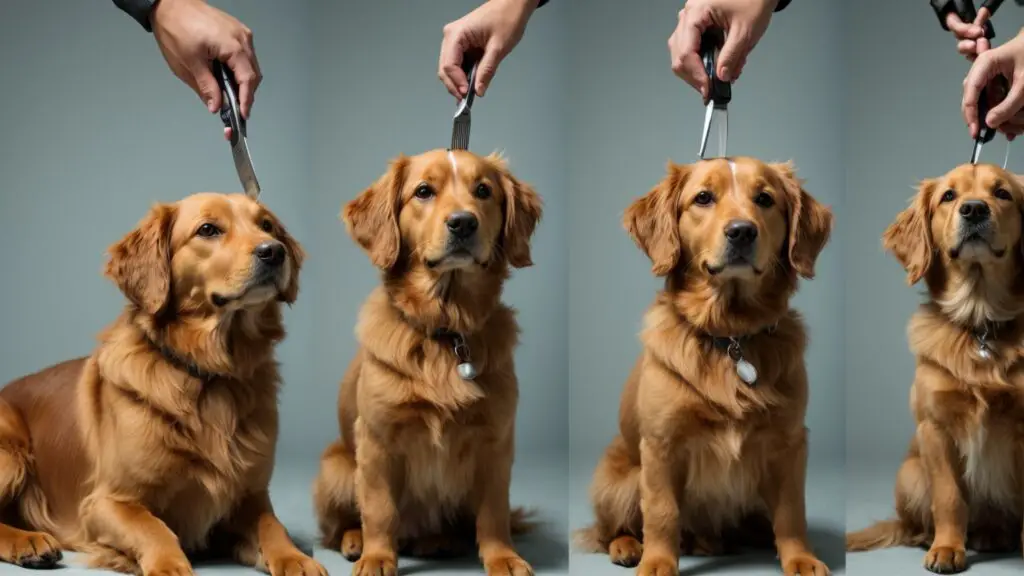
Tips for a Stress-Free Dog Nail Trim
Importance of Regular Nail Trims
Regular nail trims are an essential part of dog grooming that should not be overlooked. Long nails can cause discomfort and health issues in dogs, affecting their gait and leading to skeletal problems. Ensuring your dog’s nails are kept at an appropriate length is vital for their overall well-being. However, nail trimming can be a source of stress for both the dog and the owner. With the right approach and tools, this task can become a stress-free experience for your furry companion.
Understanding Dog Nail Anatomy
Understanding the anatomy of your dog’s nails is crucial for safe trimming. Dog nails contain a hard outer shell and an inner cuticle known as the ‘quick,’ which contains nerves and blood vessels. Accidentally, cutting into the quick can be painful and cause bleeding. The quick is visible in dogs with clear or white nails as a pink area inside the nail. However, in dogs with dark nails, it’s more challenging to see, requiring extra caution during trimming. Familiarizing yourself with this anatomy can help prevent injury and ensure a comfortable trimming experience.
In my experience, initially, my dog was apprehensive about nail trimming. However, with consistent practice and patience, it has become a routine part of our grooming sessions. The key was introducing the process gradually and ensuring it was always associated with positive experiences.
Creating a Calm Trimming Experience
Creating a calm environment for your dog during nail trimming is pivotal for a stress-free experience. Begin by choosing a quiet, comfortable space where your dog feels secure. Making this a positive experience is essential, so consider using their favorite treats or toys as a distraction and reward. Gentle petting and speaking in a soothing tone can also help to calm their nerves. Familiarize your dog with the nail trimming tools beforehand by allowing them to inspect and sniff them, reducing their anxiety about these foreign objects. If your dog shows signs of distress, pausing and proceeding only when relaxed is crucial. Consistency and patience are key; your dog will learn to associate nail trimming with a positive, stress-free experience. Remember, the goal is not just to trim their nails but to ensure the process is as comfortable and reassuring for your pet as possible.
List of Tips for a Stress-Free Experience
- Distractions: Use toys or treats to distract your dog during trimming.
- Rewards: After trimming each nail, offer treats and praise to create positive associations.
- Gradual Introduction: Start by regularly touching and holding your dog’s paws before introducing the clippers.
- Comfortable Positioning: Use a non-slip mat to ensure your dog is comfortable and secure.
- Regular Practice: Frequent, short trimming sessions are better than infrequent, long sessions.
Table: Comparison of Nail Trimming Tools
| Tool Type | Best For | Notes |
|---|---|---|
| Scissor Clippers | Thick nails, large breeds | Requires firm pressure |
| Guillotine Clippers | Smaller breeds, thinner nails | Easy to use, precise |
| Grinder Tools | Smoothing edges, anxious dogs | It takes longer, minimizes the risk of cutting the quick |
Dealing with Common Challenges
Common challenges in dog nail trimming include nervousness and the risk of cutting the hair. It’s important to remain calm and confident to address these, as dogs can sense your anxiety. If you accidentally cut the quick, use styptic powder or cornstarch to stop the bleeding.
A veterinarian once shared, “Regular nail trimming is crucial for your dog’s health. If you’re unsure about doing it yourself, schedule an appointment with a professional groomer or your vet.”
Regular nail trimming is a vital part of your dog’s grooming routine. Understanding the anatomy of your dog’s nails, using the right tools, and creating a positive experience is key to stress-free trimming. Remember, patience and consistency are essential. With time, nail trimming can become a straightforward and stress-free task, contributing to your dog’s health and happiness.
Maintaining Your Dog Coat Between Trim
Keeping the Coat Healthy Between Grooming Sessions
Maintaining your dog’s coat between professional grooming sessions is an essential aspect of dog grooming. This routine is not just about keeping your dog looking good, but it’s also about ensuring their health and comfort. A well-maintained coat helps to prevent skin irritations matting and can significantly reduce shedding. The key to effective maintenance lies in regular care, including brushing, bathing, and dietary management, which all contribute to a healthy, shiny coat.
A renowned dog grooming expert once said, “A dog’s coat is a reflection of their overall health. Regular, at-home grooming is as important as their diet and exercise.” This underscores the importance of consistent coat care in maintaining your dog’s health.
Regular Brushing Techniques
Regular brushing is crucial for all dogs, regardless of their coat type. It helps to remove loose fur, dirt, and dander, and it stimulates the skin, promoting natural oil production, which keeps the coat shiny and healthy. For dogs with an undercoat, using a de-shedding tool during brushing sessions is beneficial to remove the loose undercoat. For short-haired dogs, a bristle brush or grooming glove is typically sufficient. Brushing should be done gently to avoid irritating the skin, and it’s an opportunity to check for any lumps, bumps, or parasites.
Case Study: In a case study involving a Golden Retriever with a history of skin allergies, implementing a regular brushing routine led to a noticeable improvement in coat health. Consistent removal of loose hair and allergens trapped in the coat and regular skin inspections significantly reduced allergic reactions and improved the dog’s overall comfort.
Bathing Your Dog at Home
Bathing is another important aspect of coat maintenance. Use a dog-specific shampoo that’s gentle on the skin and designed to maintain the natural pH balance. The frequency of bathing depends on your dog’s lifestyle and coat type; however, over-bathing can strip essential oils from the skin and lead to dryness. For dogs who love to roll in the mud or swim, rinsing with plain water between shampoos can help keep the coat clean without overdoing it.
Dietary Considerations for Coat Health
Diet plays a pivotal role in the health of your dog’s coat. A balanced diet of essential fatty acids, vitamins, and minerals is vital for maintaining a healthy skin and coat. Supplements like fish oil can be beneficial, especially for dogs with dry or itchy skin. Always consult your veterinarian before introducing new supplements to your dog’s diet.
Maintaining your dog’s coat between grooming sessions is a multi-faceted approach that involves regular brushing, appropriate bathing, and a balanced diet. It’s a critical part of pet grooming that keeps your dog looking their best and is essential to their overall health and well-being. Remember, a healthy coat is a sign of a healthy dog, and regular at-home grooming is key.
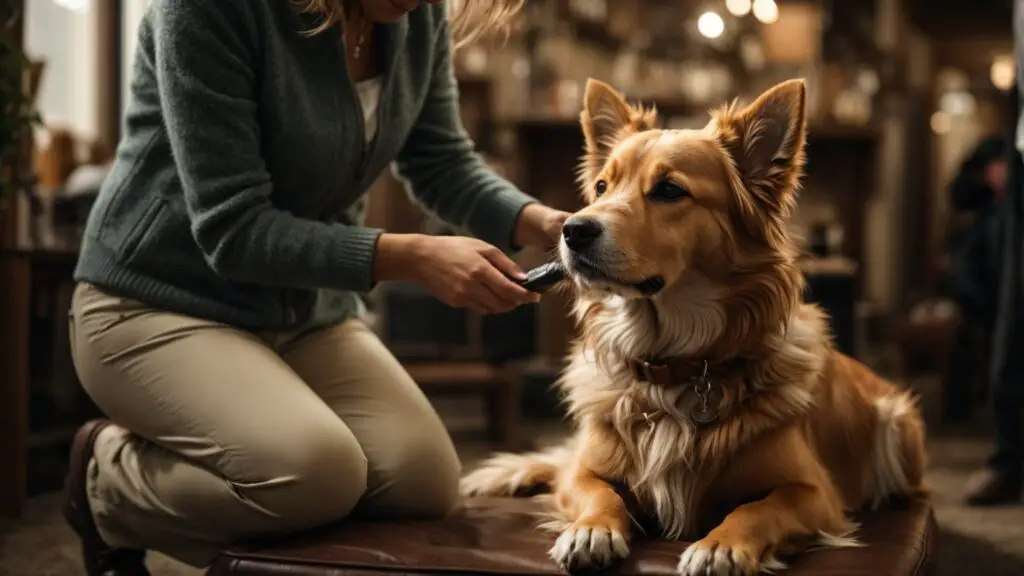
Common Mistakes to Avoid in Dog Grooming
Common Pitfalls in Home Dog Grooming
Navigating the world of dog grooming can be a complex task, especially when doing it at home. While grooming your dog is an essential part of their care, certain common mistakes can compromise the effectiveness of your efforts and even impact your dog’s health and comfort. Understanding these pitfalls is crucial for ensuring a positive grooming experience for you and your furry companion.
I encountered several hurdles when I first began grooming my dog at home. One of my initial mistakes was not realizing the importance of regular nail trims, leading to discomfort for my dog. Over time, and after some research and advice from a professional groomer, I learned the correct techniques and the importance of a comprehensive grooming routine, which includes coat care, nail trimming, and ear cleaning.
Over-trimming and Uneven Cuts
One common mistake in dog grooming is over-trimming or creating uneven cuts, especially when trying to achieve a specific style or length. This usually happens when owners are unfamiliar with the right techniques or use inappropriate tools. Over-trimming can expose the skin to environmental factors and cause discomfort. To avoid this, always use sharp, appropriate-sized grooming tools and follow the natural lines of your dog’s body. If unsure, it’s always better to trim less and schedule an appointment with a professional dog groomer for guidance.
Neglecting Nail Care
Another critical aspect often overlooked is nail care. Nails that are too long can cause pain, affect your dog’s gait, and even lead to skeletal problems. Regular trimming is essential, and it’s important to know the anatomy of the nail to avoid cutting into the quick, which can be painful and lead to bleeding. Extra caution is needed for dogs with darker nails, where the quick is not visible.
Table: Mistakes and Solutions in Dog Grooming
| Mistake | Solution |
|---|---|
| Over-Trimming | Trim gradually, following the coat’s natural pattern; use the correct tools. |
| Uneven Cuts | Use steady hands; consider professional help for complex styles |
| Neglecting Nail Care | Regular trimming; learn the correct technique to avoid quick |
| Ignoring Skin and Coat Health | Regular brushing; use suitable shampoo and conditioner |
Ignoring Skin and Coat Health
Ignoring the health of your dog’s skin and coat can lead to various issues like matting, skin infections, and increased shedding. Regular brushing, using the right grooming tools, and bathing with dog-specific shampoos are vital. Pay attention to any skin irritation or unusual hair loss during grooming sessions.
Avoiding common grooming mistakes involves being mindful of your dog’s overall grooming needs, including coat maintenance, nail care, and skin health. Regular grooming is more than just aesthetic; it plays a significant role in your pet’s health. If ever in doubt, seeking advice or services from a professional grooming salon is always advisable. Effective grooming is a key pet care component, contributing significantly to your dog’s overall well-being.
Advanced Dog Grooming Techniques
Taking Dog Grooming to the Next Level
Advanced dog grooming goes beyond regular brushing, bathing, and nail trimming. It involves intricate skills and techniques to enhance your dog’s appearance and well-being significantly. This level of grooming is particularly beneficial for dog shows or simply for those who want their furry companions to look their best. Advanced grooming techniques require patience, precision, and understanding of your dog’s breed and coat type.
My journey into advanced dog grooming began with a desire to give my dog a unique look that reflected his personality. Starting with the basics, I gradually learned more complex techniques, attending workshops and following guidance from seasoned groomers. It was a process filled with trial and error, but it was immensely rewarding when I saw the results of my efforts reflected in my dog’s well-groomed appearance and boosted confidence.
Specialized Dog Coat Trim Techniques
Specialized trimming techniques are a cornerstone of advanced dog grooming. This includes breed-specific trims, like the Poodle’s Continental Clip or the Schnauzer’s traditional cut, which require understanding how to accentuate the breed’s features properly. Hand-stripping, a technique used on certain wire-haired breeds to maintain the coat’s texture and color, is an essential skill in advanced grooming. Each technique demands knowledge of the dog’s coat type and growth patterns, ensuring the grooming looks good and benefits the dog’s coat health.
Table: Overview of Advanced Grooming Techniques
| Technique | Description | Suitable for Breed/Coat Type |
|---|---|---|
| Breed-Specific Trimming | Tailored cuts that enhance breed characteristics | Poodles, Schnauzers, etc. |
| Hand-Stripping | Removal of dead hair to promote new growth | Wire-haired breeds like Terriers |
| Creative Grooming | Using colors and patterns for a unique look | All breeds require non-toxic dyes |
Creative Grooming Ideas
Creative grooming is an art form where groomers use safe, pet-friendly dyes and creative haircuts to transform dogs into works of art. This can range from simple color accents to elaborate designs and patterns. While creative grooming is primarily for aesthetic purposes, it’s important to use products formulated for dogs to avoid skin irritation or health risks.
A professional dog groomer once said, “In advanced grooming, the only limit is your imagination. But always prioritize your dog’s comfort and safety.”
Advanced dog grooming is an exciting field that combines artistic expression with meticulous care for your dog’s coat and skin. Whether mastering breed-specific cuts or exploring the realms of creative grooming, these techniques take the grooming experience to a new level. It’s essential, however, to always prioritize your dog’s comfort and safety and consult with a professional grooming salon or veterinarian when trying new grooming styles. With the right approach, advanced grooming can be a fulfilling way to bond with your dog while keeping them looking their best.
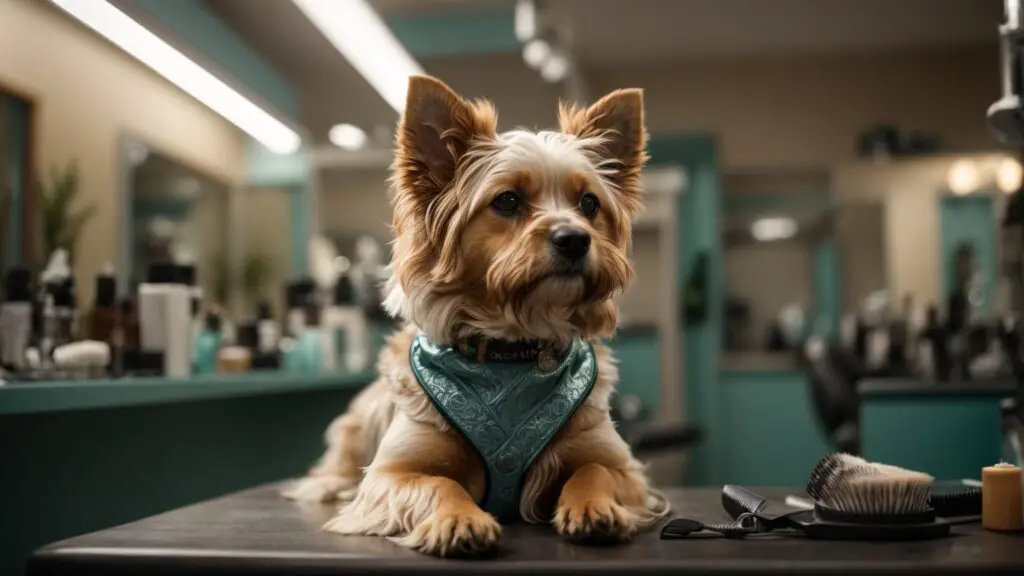
Conclusion
In this comprehensive guide, we’ve explored the multifaceted world of dog grooming, emphasizing the importance of regular grooming routines for maintaining the health and happiness of your furry friend. Each aspect is critical in ensuring your dog’s well-being, from the basics of dog nail trim and coat care to advanced grooming techniques. We delved into the essentials of grooming, highlighting the importance of having the right tools and understanding your dog’s unique needs, whether they have a double coat, short hair, or sensitive skin.
The journey of grooming your dog at home is filled with learning and bonding. As we’ve seen, regular grooming is not just about maintaining a good appearance; it’s an essential part of caring for your dog’s health. It’s a chance to check for any underlying health issues, from skin irritations to the need for a nail trim. The personal anecdotes and expert advice this guide shares underscore the depth of care and attention required in dog grooming. Remember, whether you’re performing a basic haircut, managing loose hair, or embarking on more intricate grooming styles, the comfort and safety of your pet should always be your top priority.
I encourage all dog owners to embrace the rewarding task of grooming their dogs at home. While it may seem daunting initially, patience and practice make it an enjoyable and fulfilling part of your relationship with your pet. Not only does it strengthen your bond, but it also ensures that your dog always feels their best. If you ever feel uncertain, don’t hesitate to contact your local grooming salon or schedule an appointment with a professional who can guide you. Remember, every stroke of the brush, every trim of the nail, contributes to your dog’s health and happiness. Embrace these moments, and enjoy the journey of providing the best grooming experience for your beloved companion.
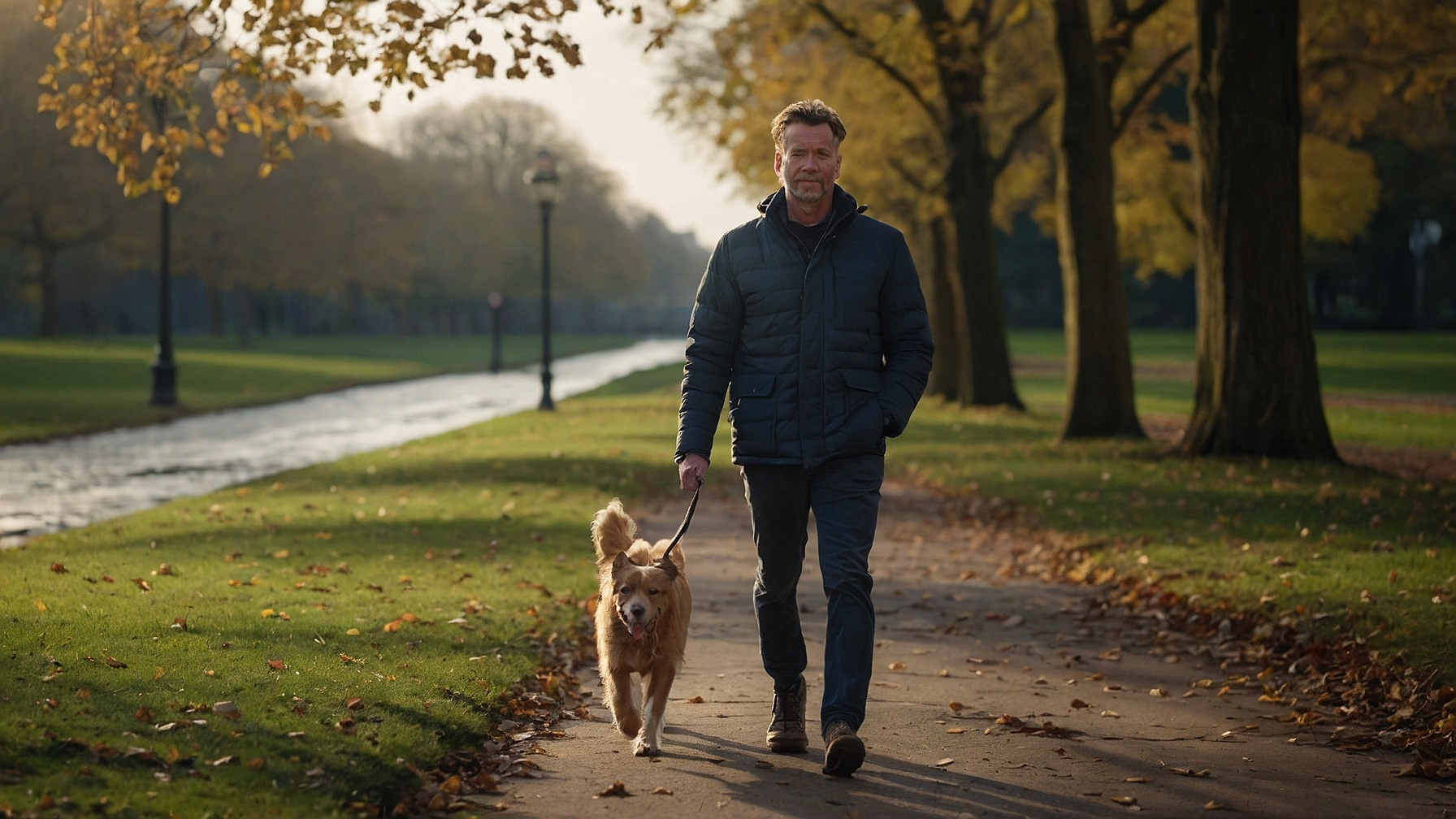
James Dunnington leads the James Dunnington Collection, featuring five unique blogs: a practical Pet Care Guide, an enlightening Ancient History Blog, a resourceful Home Improvement Guide, a cutting-edge Tech Innovation Guide, and a strategic Online Money Making platform. Each site delivers valuable insights designed to empower and inform. For updates and more tips, visit our Contact Us page to sign up for our newsletter, ensuring you never miss out on the latest content from any of these dynamic fields.